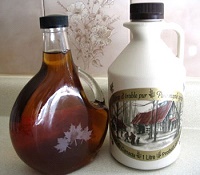Click here for a
PDF print version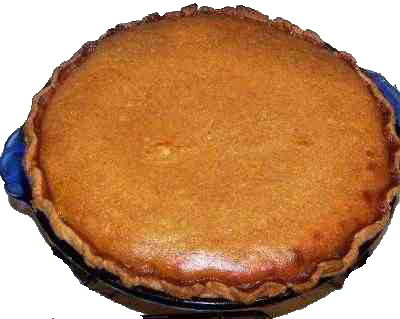
If you like this recipe, you'll probably also like my easy pumpkin cheesecake recipe, pumpkin bread, pumpkin butter, pumpkin soup and complete, easy directions to cook a Roast Turkey dinner, easy, tasty, healthy turkey gravy, applesauce, easy apple butter, cranberry sauce and cran-apple sauce. And if you have never canned or made jam, applesauce, apple butter, etc, before, never fear, it is easy with my canning directions. Don't forget to use see these Christmas tree farm pages to find a cut-your-own tree farm or fresh-cut farm or lot near you! They're loads of fun, often with Santa visits, sleigh rides or hayrides, sometimes even live reindeer and more.
Just have a Jack O Lantern? If all you have is a Jack O Lantern pumpkin (no pie pumpkin or butternut squash) then see this page for the recipe to make a pie from an ordinary carving pumpkin.
Directions for Making Maple Syrup Pumpkin Pie from Scratch
Yield: It really depends on the size
of the pumpkin and the size of your pie plate. If you use a 6" pie
pumpkin and a full deep dish 9" pie plate, then it should fill that pie
to the brim and maybe have enough extra for either a small (4 inch) shallow pie
(or a crustless pie - see step 11).
Some people manage to make 2
full pies, especially if they use shallow pie plates and/or 8 inch pie
plates.
Ingredients and Equipment
Equipment
- A sharp, large serrated knife
- an ice cream scoop
- a large microwaveable bowl or large pot
- 1 large (10 inch) deep-dish pie plate and pie crust (Click here for illustrated pie crust instructions! they will open in a new window) - or two small pie plates (9 inch) and crusts
Ingredients
- a pie pumpkin (see step 1; you can use different types of pumpkin or even a butternut squash)
- 1 cup maple syrup (500 ml)
- 1.5 teaspoon ground cinnamon (metric: 3.8 grams)
- 1 teaspoon ground cloves (metric: 2 grams)
- 1 teaspoon ground allspice (metric: 2 grams) ( Other names for allspice are: Piment de la Jamaïque, Maustepippuri, Kryddpeppar, Piment, Korzennik lekarski, Ienibahar, Pimentovník pravý)
- 1/2 teaspoon ground ginger (metric: 1.25 grams)
- Optional: 1/2 teaspoon mace (which you'll find in the very old pumpkin pie recipes)
- 1/2 teaspoon of vanilla extract (optional) (metric: 20 grams)
- 1/2 teaspoon salt (optional, I don't use any)
- 4 large eggs - to reduce fat and cholesterol, you may use egg whites (like "Egg Beaters) instead, and vegans may want to use Ener-G (see this page for more information about egg substitutes)
- 3 cups pumpkin glop (ok... "sieved, cooked pumpkin") (metric: 0.7 litre)
- 1.5 cans (12oz each) of evaporated
milk (I use the nonfat version) for best results. (metric: each can
is about .35 liter, or about a half liter total))
Note for the UK and Europe: Nestle Carnation has two sizes of cans in England: 170g and 410g - the large 410g can is 14 fl. oz. and the small 170g can is 5 fl. oz. (the same as the small can in the US). Use one of each (19 fl. oz. total) in your pie.
Other notes:
If you can't get canned evaporated milk, make your own from nonfat dried milk and make it twice as concentrated as the directions on the box call for!
If you can't get nonfat dried milk, just use milk.
If you are lactose-intolerant, use lactose-free milk or soy milk.
One visitor tried fresh whipping cream (unwhipped) and reported the pie "turned out wonderful! "
Another suggests using coconut milk, if you are allergic to dairy.
Note: if you do not have cinnamon, cloves, allspice and ginger, you can substitute 3 teaspoons of "pumpkin pie spice". It's not exactly the same, but it will do.
Note: If you can't get evaporated milk, you can substitute nonfat dried milk - make it twice as concentrated as the directions on the box say to reconstitute it. It won't be the same as evaporated milk, but it ought to come close.
Recipe and Directions
Yield: One 9-inch deep dish pie or two 8-inch shallow pies
Step 1 - Get your pie pumpkin
"Pie pumpkins" are smaller, sweeter, less
grainy textured pumpkins than the usual jack-o-lantern types.
Grocery stores usually carry them in late September through December in
the U.S. In some parts of the country, they are also called sugar
pumpkins or even "cheese pumpkins". Go figure that one. Note: the Libby's can of cooked pumpkin is just there
for reference - it is the small can, so that gives you an idea of the size
of a typical pie pumpkin. They're only about 6 to 8 inches in diameter
(about 20 to 24 inches in circumference).
TIP: If you're in a pinch and can't find a pie pumpkin, here's a tip: butternut
squash taste almost the same! Commercial canned pumpkin is from a
variety of butternut, not true pumpkins! If you insist on using a regular Jack O'
Lantern type pumpkin, you may need to add about 25% more maple syrup and run the
cooked pumpkin through a blender or food processor to help smooth it out.
Just like selecting any squash, look for one that is firm, no bruises or soft spots, and a good orange color. One 6" pie pumpkin usually makes one 10 inch deep dish pie and a bit extra; or 2 9 inch shallow pies!
If you live in the Far East (Thailand, Japan, Korea, Hong Kong, etc.) and cannot get a pumpkin or a butternut squash, I'm told that Japanese pumpkins make a great substitute. Just cube the meat into small cubes and steam them for 35 minutes. The rest of the preparation is the same and I'm told the taste is great.
Step 2 - Prepare the pumpkin for cooking
Wash the exterior of the pumpkin in cool or
warm water, no soap.
Cut the pumpkin in half. A serrated knife and a sawing motion works best - a smooth knife is more likely to slip and hurt you! A visitor suggests using a hand saw.
Step 3 - Scoop out the seeds...
And scrape the insides. You want to
get out that stringy, dangly stuff that coats the inside surface. I
find a heavy ice cream scoop works great for this.
Note: SAVE THE SEEDS:
The seeds can be used either to plant pumpkins next year, or roasted to eat this year! Place them in a bowl of water and rub them between your hands. then pick out the orange buts (throw that away) and drain off the water. Spread them out on a clean towel or paper towel to dry and they're ready to save for next year's planting or roast. Click here for roasting instructions! (opens in a new window)
Step 4 - Cooking the pumpkin
There are several ways to cook the pumpkin; just choose use your preferred method. Most people have microwaves and a stove, so I'll describe both of those methods here. But others make good arguments in favor of using a pressure cooker or baking in the oven. At the end of this document, I've included alternative instructions to replace step 4, if you'd rather use a different method.Method 1 - Put it in a microwaveable bowl
Remove the stem, and put the pumpkin into a
microwaveable. You may need to cut the pumpkin further to make it fit.
The fewer the number of pieces, the easier it will to scoop out the cooked
pumpkin afterwards.
Put a couple of inches of water in the bowl, cover it, and put in the microwave.
Method 2 - Steam on the stovetop
You can also cook it on the stovetop; it takes about the same
length of time in a steamer (20 to 30 minutes). I use a double pot steamer, but you
could use an ordinary large pot with a steamer basket inside it!: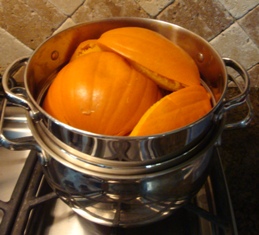
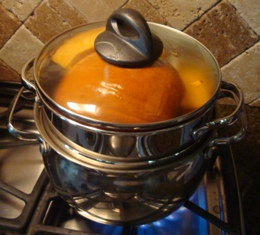
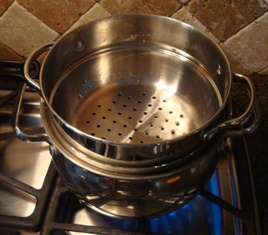
Step 5 - Cook the pumpkin until soft
Either
way, cook for 15 minutes on high, check to see if
it is soft, then repeat in smaller increments of time until it is soft
enough to scoop the innards out. Normally it takes 20 or 30 minutes
in total.
Step 6 - Scoop out the cooked pumpkin
Whether
you cook the pumpkin on the stove, microwave, or even the oven, once it
is cooked until it is soft, it is easy to scoop out the guts with a broad, smooth spoon, (such as a
tablespoon). Use the spoon to gently lift and scoop the cooked pumpkin out of the skin.
It should separate easily an in fairly large chucks, if the pumpkin is
cooked enough.
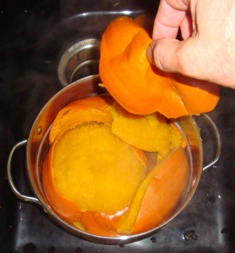 Many
times the skin or rind will simply lift off with your fingers (see the
photo at left) . I'll bet you didn't realize making your own
pumpkin glop... err, "puree" was this easy!
Many
times the skin or rind will simply lift off with your fingers (see the
photo at left) . I'll bet you didn't realize making your own
pumpkin glop... err, "puree" was this easy!
Note: there are many varieties of pumpkin and some make better pies that other (due to sugar content, flavor, texture and water content. Drier, sweeter, fine-grained pies; the small (8" across) ones called "pie pumpkins" are best.
Watery pumpkin?
If your pumpkin puree has standing, free water, you may want to let it sit for 30 minutes and then pour off any free water. That will help prevent you pie from being too watery! Beyond, that, I have not found that the water makes a difference - I wouldn't be TOO concerned about it!
Tip from a visitor: "I make my own pumkin pies from scratch all the time. To eliminate watery pumpkin I strain my pureed pumpkin through a cloth overnight. If I use frozen pumpkin I do the same again as it thaws out. It works great and my pies cook beautifully."
Another visitor reported success using coffee filters in a sieve to drain out excess water.
Again, don't go to great lengths to remove water; the recipe accounts for the fact that fresh pumpkin is more watery than canned!
Step 7 - Puree the pumpkin
To
get a nice, smooth consistency, I use a Pillsbury hand blender. By
blending it, you give the pie a smooth, satiny texture; rather than the
rough graininess that is typical of cooked squashes.
A regular blender works, too (unless you made a few frozen daiquiris and drank them first..). Or a food processor or even just a hand mixer with time and patience.
With the hand blender, it just takes 2 or 3 minutes!
Another visitor says using a food mill, like a Foley Food Mill, with a fine screen, accomplishes the blending/pureeing very well, too!
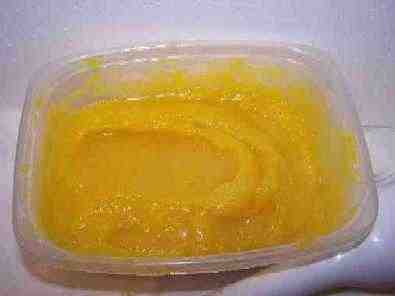 Step
8 - Done with the pumpkin!
Step
8 - Done with the pumpkin!
The pumpkin is now cooked and ready for the pie recipe. Get the frozen daiquiris out from step 7 and take a break! :)
Note: You may freeze the puree or pie filling to use it later! Just use a freezer bag or other container to exclude as much air as possible. It should last a year or more in a deep freezer On the other hand, you may NOT "can" it: See this page for the safety reasons why you shouldn't can it.)
Step 9 - Make the pie crust
Yes, I know there are ready-made pie crusts in the frozen section at the store, but they really are bland and doughy. A flaky crust is easy to make! Again, note that unless you use large, deep dish pie plates, you may have enough for 2 pies.
It is also time to start preheating the oven. Turn it on and set it to 425 F (210 C, for those in Europe)
Click here for illustrated pie crust
instructions!
(it will open in a new window)
Step 10 - Mix the pie contents
All the hard work is behind you! Here's
where it gets really easy. If you start with a fresh 8" pie pumpkin, you
will get about 3 cups of cooked, mashed pumpkin. Th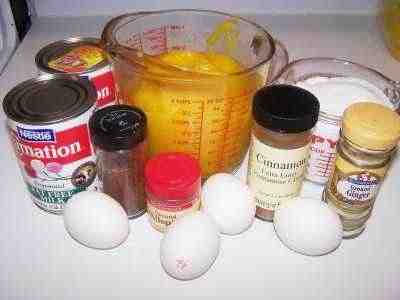 e right amount of
ingredients for this is as follows:
e right amount of
ingredients for this is as follows:
- 1 cup maple syrup - or 1 cup Splenda, or 3/4 cup honey (honey may make a heavier pie, though)
- 1.5 teaspoon ground cinnamon
- 1 teaspoon ground cloves
- 1 teaspoon ground allspice
- one half teaspoon ground ginger
- one half teaspoon salt (optional, I don't use any)
- 4 large eggs
- 3 cups pumpkin glop (ok... "sieved, cooked pumpkin")
- 1.5 cans (12oz each) of evaporated milk (I use the nonfat version)
Mix well using a hand blender or mixer.
Note: You may substitute 2 tablespoons of "pumpkin pie spice" instead of the cinnamon, cloves, allspice and ginger. But I think you get better results with the separate spices.
Note: The vast majority of people tell me this is the best pumpkin pie they've ever had. It's light and fluffy - however... if you want a heavy, more dense pie, use 3 eggs instead of 4 and 1 can of evaporated milk instead of 1.5)
Step 11 - Pour into the pie crust
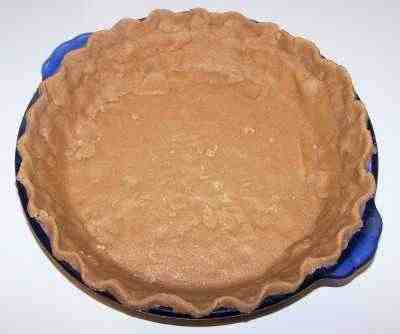 I like a deep, full pie, so I fill it right
up to about one quarter to one half inch from the very top.
I like a deep, full pie, so I fill it right
up to about one quarter to one half inch from the very top.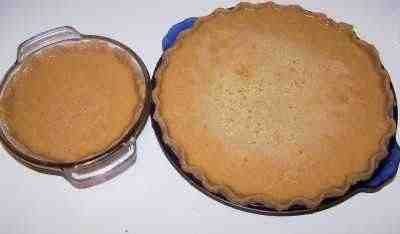
Don't be surprised if the mixture is very runny! It may start as a soupy liquid, but it will firm up nicely in the oven! Note: the pie crust is brown because I used whole wheat flour! Tastes the same, but is healthier.
TIP: What do you do if you end up with more filling than will fit in your pie crust(s)? Easy! Of course, you can make another, smaller pie crust and fill a small pie pan... or just grease any baking dish, of a size that the extra filling will fill to a depth of about 2 inches (see the photo at right), and pour the extra filling in.. then bake it. It will be a crustless pumpkin pie that kids especially love!
TIP: You may want to cover the exposed edges of the crust with strips of aluminum foil to prevent them from burning!
Step 12 - Bake the pie
 Bake at 425 F (210 C ) for the first 15 minutes, then
turn the temperature down to 350 F ( 175 C ) and bake another 45 to
60 minutes, until a clean knife inserted into the center comes out
clean.
Bake at 425 F (210 C ) for the first 15 minutes, then
turn the temperature down to 350 F ( 175 C ) and bake another 45 to
60 minutes, until a clean knife inserted into the center comes out
clean.
Here is the finished pie, right out of the oven:
I use a blunt table knife to test
the pie. The one at left has already been stuck in the pie, and you
see it comes out pretty clean, when the pie is done.
Step 13 - Cool the pie
And enjoy!
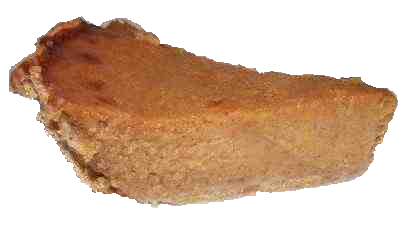 Warm
or chilled, with whipped cream , ice cream or nothing at all - it's great!
Warm
or chilled, with whipped cream , ice cream or nothing at all - it's great!
Alternative Cooking methods for step 4
If you don't have a microwave, or prefer another method, try these:Stovetop steaming - Place your steaming basket or grid in the bottom of a large pot. Put enough water so it won't boil dry in 20 minutes, and yet is not so high that the pumpkin is touching the water level. You may need to add more water during the cooking. Add the pumpkin prepared in step 3, and get the steamer going. The cooking time is only between 8 and 12 minutes, depending on the range (gas or electric), and the pumpkin literally falls off the skin.
Pressure cooker - Place your grid in the bottom of the pressure cooker. If your pressure cooker came with directions, follow those for pumpkin and/or winter squash, like butternut squash. If, like most people, you've long since lost the directions, try this: Add enough water to just touch the bottom of the grid or shelf that you will place the pumpkin on. Add the pumpkin prepared in step 3, put the lid with the gasket, the weight and anything else your cooker requires in place, and turn the heat on high. Once it starts hissing, turn it to medium or medium high. The cooking time should only be about 10 minutes, and the pumpkin should literally fall out of its skin.
Oven - You can also bake the prepared pumpkin in the oven, just like a butternut squash. This method takes the longest. Just put the prepared pumpkin in an ovenproof container (with a lid), add about 3 cups of water to help prevent it from drying out and pop it in an 350 F (175 C) oven. It normally takes about 45 minutes to an hour; just test it periodically by sticking it with a fork to see if it is soft!Tips from Visitors
Making a pie with a Jack O' Lantern: A visitor writes on November 10, 2008: "I have a suggestion for those who want to use a jack o lantern pumpkin. My son was so happy when he went on his first field trip to the pumpkin patch. He made me promise to make pumpkin pies with his big giant pumpkin. I did just as you said baked it, put it in the frig over night. Then I put the pieces in a pot and cooked it until it was like mush added a big cinnamon stick and and the maple syrup boiled some of the water out and 4 great pies. Thank you for your recipe it worked wonder full!!!"Covering the edges of the crust: A visitor writes on November 19, 2008: "After having lost my old beloved recipe, I tried this one and have to say this one is top notch! One tip that might help to pass on (especially to new pie makers) is to cover the edges with aluminum foil to prevent the crust from burning. It really works and makes those yummy pie crusts as delicious as the rest of the pie!"
Mashing the cooked pumpkin: A visitor writes on November 26, 2008: "Hello, great site here. I tried your pumpkin pie recipe and it came out great. Just wanted to add my two cents on pumpkin pie making. After cooking the pumpkin and scooping it out, you can use a potato ricer to mash it. When you first put the pumpkin in ricer and squeeze the handles together you get a decent amount of water squeezed out first. Then I put the ricer over bowl and squeeze the pumpkin out. The ricer mashes and gets water out at same time. Plus, another good thing is that a lot of the fiberous strings in pumpkin gets trapped at bottom of the ricer cup and not in the pumpkin puree. I bought my potato ricer at bed bath and beyond for fifteen bucks, so its cheap too. Hope this helps."
Baking tips:
A visitor writes on November 19, 2008: "I learned a trick about baking large squashes and pumpkins many years ago. I just poke a few holes in it, put it on a baking sheet whole, and bake it at around 325 degrees until the squash/pumpkin is tender. When it's cool, it's easy to cut in half, scoop out the seeds, and peel. It is also much less watery this way. This has always worked well for me. You do have to start a little earlier, though. Baking it this way and then letting it get cool enough to handle
A visitor writes on November 20, 2008: "I have made pumpkin pies from pumpkins for years and the best, most flavorful method is to cut in half, oil and roast, face down on high heat -- it carmelizes a bit, then I do drain it and boil down the water til it is thick and medium caramel color and add it to the puree -- adds a lot of flavor. yum :)"
Oven prep method: A visitor writes on November 26, 2008: "Another way to prep pumpkin that seems to get a consistent non-stringy finish regardless of pumpkin species: 1. Halve pumpkin and remove innards. 2. Place halves face-down on a greased cookie sheet. 3. Roast at 400 long enough for skins to visibly darken. 4. All species will come out firm, golden, and generally already separated from the shell. 5. Puree can be accomplished with a potato masher if desired. More watery pumpkins will drain and cook like pie pumpkins. Though messier in your oven, I have the best luck using a flat cookie sheet that allows the water to drain off and burn in the oven."
Starting with a frozen pumpkin: A visitor writes on November 27,
2008: "Just wanted to add to your ideas about making pumpkin pies
out of fresh pumpkins. I was preparing to make my pies for Thanksgiving
and realized I had forgot to buy pumpkin. I read your site about the
different ways to make pumpkin pies from fresh pumpkin ~ and, having
pumpkins on my front porch for fall decorations, I went and grabbed one
to use only to discover it had been frozen solid! (Our temps had dropped
to 7° a few days before.) I had no choice but to give it a try. As it
started to thaw it became soft. Here's what I did: Cut out the stem, cut
the whole thing in half, scooped out the seeds, peeled the halves - I
actually cut those in half to make peeling easier - and cubed the
remaining into little bitty pieces. I put it all in a large covered
sauce pan and slowly cooked it. Once they got soft enough I took a
potato masher to it and cooked some more. Worked GREAT! I'll put it in a
blender before using, but it was easy! Just cook real slow so as not to
burn or scorch. But the frozen pumpkin started the break-down process
and made cooking them much quicker and simpler. Just thought it a good
alternative if anyone was interested. Thanks for the great site!!"
Frequently Asked Questions
Q. I would like to make your pumpkin pie from scratch for my family for Thanksgiving. What would be the best way to do this? Can I make a pie now and freeze it? Can I buy the small pumpkins now and hold on to them until the week before Thanksgiving and make the pie?
Yes, the cooked pumpkin pies freeze pretty well, but of course, everything's a little better fresh. Pie pumpkins keep very well in a cool basement or garage (between 40 F and 60F), and they'd certainly keep until Thanksgiving if they are in good shape now (no bruises or soft spots).
Q. I live in Europe, so I do not have all of the U.S. ingredients over here. I'm also not that clear on the measurement conversions for Example: 1 Cup = how many oz or grams (better for me) dry goods-flour and from oz to grams or liters for wet goods-cream? I was wondering if you would also possibly know substitutes for the following items: Allspice (cinnamon?), Evaporated milk (Lowfat Cream? But then not sweetened! Add more sugar?), Crisco Vegetable Shortening (Help - no idea!)
No problem! I lived and worked in Europe for 7 years, so I found a lot of good substitutions.
1 cup = 1/4 liter - about 250 ml
A visitor tells me that according to New Zealand's most trusted cookbook, Edmonds:
1 cup of Flour = 175 g (6 oz)1 cup of Maple Syrup = 500 ml
Evaporated milk is unsweetened milk that has the volume reduced by removing some of the water - it is sort of like concentrated milk - about 50% reduced, still quite watery. You could make your own by adding 100 ml (by volume) of instant dried milk to each 100 ml of regular lowfat (or skim or nonfat) milk.
Allspice is it's own spice! It is the dried, unripened fruit of a small evergreen tree, the Pimenta Dioica (typically grown in Jamaica). The fruit is a pea-sized berry which is sundried to a reddish-brown color. Pimento is called Allspice because its flavor suggests a blend of cloves, cinnamon and nutmeg. So you could make a blend of equal parts of cloves, cinnamon and nutmeg instead.
Crisco shortening is a vegetable substitute for lard, and adds no flavor. You could use butter, margarine, or even (ugh!) lard, in place of it. If you are the UK, there is something called Trex vegetable fat in the refrigerated section of the supermarket near the butter. I'm told it a good substitute for Crisco.
Q. My 8 year old son grew some pumpkins this year, so I tried your pumpkin pie recipe. I following all the instructions and the only thing I didn't do was make my own pastry I used the frozen variety. Unfortunately the pie only partially set and was full of clear liquid at the bottom making the pastry base soggy. I don't know what I did wrong?
Most likely it was the variety of pumpkin you grew - some are more watery. The small (8 inches across) “pie” pumpkins like they sell in Kroger are best. Next year choose a variety to grow that says it is good for pies, such as “Connecticut Field” or “pie pumpkin”. Generally, these varieties are also more sweet, finer grained and less watery than Jack O Lantern pumpkins.
Easy solutions, if you must use a Jack O' Lantern type pumpkin are to let the pumpkin pulp sit in the fridge for a few hours. The water will separate and can be poured off. Another solution is to add 2 more eggs to the recipe and also cook another 20 minutes longer to get a firmer set.
